Wednesday, September 27, 2006
I mixed 1/2 cup of brown sugar with 5 heaping tablespoons of the Pit Master then rubbed it generously all over the rack of ribs. The result was very good. TheWife like it a lot, since the rub wasn't quite as sweet as I usually make it. I like them really sweet, she only wants a hint of the sweet stuff. So there has to be a balance. All in all a fine product for good barbecue.
"
Wednesday, April 12, 2006
Toffee is a hard candy made mainly with sugar and butter. In America, the term "English toffee" is generally used for toffee prepared with a coating of chocolate and almonds. This recipe is easy to prepare and yields a full flavored, crunchy toffee that has just a little "stickiness" when chewed.
To create toffee, we will basically heat sugar and butter until the sugar reaches the hard crack stage (300°F / 150°C). If you don't allow the sugar to reach this temperature before cooling, the texture will be different. For example, if heated to the soft crack stage (the temperature range just below hard crack), the candy would be more like a butterscotch than a brittle, crunchy toffee. (In some parts of the world, this is also considered a toffee, but it's not what comes to mind when I hear the word.) If the sugar is heated beyond 320°F (160°C), then it might not retain its solid form and turn into liquid caramel over time.
Assemble the ingredients: 6 oz. (170 g) semi-sweet chocolate chips, 1 cup (200 g) sugar, about 1/2 cup (60 g) chopped almonds, 1 (5 mL) teaspoon vanilla extract, 1/8 teaspoon salt, and 1 cup (225 g) unsalted butter.
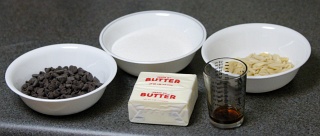
Select a small saucepan. Make sure the saucepan is large enough to contain about double the volume of the butter and sugar. As the mixture cooks, it will bubble and increase in volume - using too small of a pan may result in overflows.
Melt the butter in the saucepan with the sugar and salt plus a little (about 2 teaspoons, 10 mL) water. The extra water will make it easier for the sugar to heat evenly and melt together.
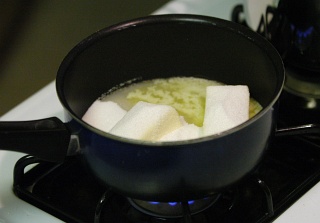
Stir the mixture constantly while heating over medium-high heat. The butter and sugar will bubble and foam as the water boils off. This can take several minutes because butter contains a decent amount of water. The volume of the mixture will increase dramatically at this point. At this point the temperature should be relatively constant at a few degrees above the boiling point of water.
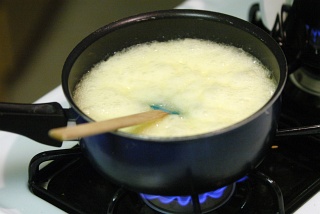
Once the water has boiled off, the mixture will collapse and thicken. The temperature will also start to rise again. The goal is to remove the pan from the heat once the mixture passes 300°F (150°C) and before it reaches 320°F (160°C). Use an instant read thermometer or candy thermometer to keep track of the temperature as you heat and stir because the temperature can change pretty rapidly once the water boils off.
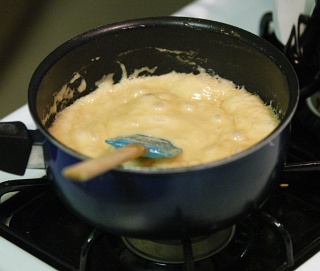
When the mixture reaches 300°F (150°C), remove it from the heat and stir in the vanilla extract. Pour the mixture onto either a silicone baking mat or a large sheet of parchment paper set on top of a sheet pan. The silicone baking mat is probably easiest to work with since it won't slide around on the sheet pan. If you're using parchment paper, one way to keep it in place is to dab the underside of the four corners with a little bit of butter. That will help the paper stay put while the toffee is poured on.
Right after pouring, use a spatula (again silicone works best for working with toffee) to spread the toffee into a rough rectangular shape.
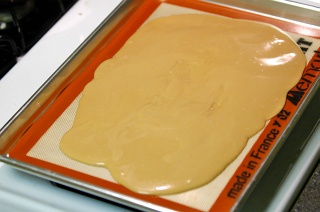
While the toffee is still hot, sprinkle the surface with the chocolate chips. Wait until the bottoms of the chips start to turn shiny and dark brown as they melt from the heat of the toffee, about two minutes. Use your spatula to spread the chocolate. If the chocolate is still mostly solid, wait another minute before attempting to spread again.
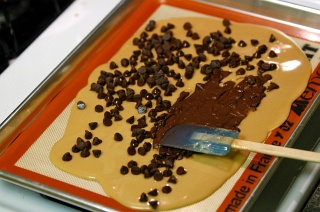
Spread the chocolate so that it covers the toffee.
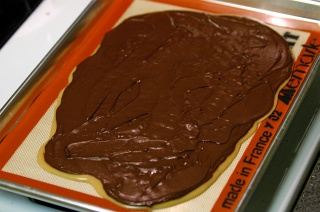
Sprinkle the chocolate surface with chopped almonds. If not using finely chopped almonds, such as the slivered almonds shown in the photos, visually inspect the the surface of the toffee to make sure the almonds are making good contact with the chocolate. Lightly press down on those pieces that are barely touching the surface of the chocolate.
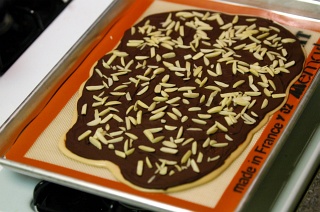
Let the toffee cool for about twenty minutes until the sheet pan returns to room temperature. Slip the pan into the refrigerator to cool down and set for at least thirty minutes.
Remove from the refrigerator and peel the toffee from the baking mat or parchment paper. Working quickly so the chocolate doesn't melt too much, break the toffee into chunks of the desired size and place into an airtight container. During the breaking of the toffee, you'll lose quite a few almond pieces, but don't worry, this is normal.
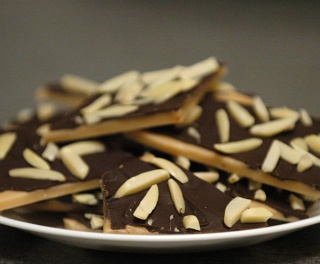
Ordering New England Style Clam Chowder at a restaurant is an irresistible temptation for me. I always have to try it because everyone makes it a little different. My most common complaint is the lack of clams in many restaurant clam chowders, so I prepare my own whenever I have some extra cream on hand. My recipe balances the generous portion of clams with a satisfying amount of potatoes and clam juice to provide a briny flavor to this cream-based chowder. Steamed fresh clams can replace the canned clams if you have time or want to bring this recipe to the next level.
There are countless varieties of clam chowder - the most popular of which are called New England Style and Manhattan Style. The label New England Style has come to mean that the chowder has a cream or dairy base while Manhattan Style refers to a tomato base. A brief Google search reveals that the terms Maine style (heavy cream), Rhode Island style (light cream / soupy), Oregon style (extremely thick), Yorktown style (containing beer or ale), and Southern style (more vegetables and spices with some Worcestershire sauce) are also used - but I have yet to see them served in a restaurant. Of course, some restaurants' New England Style clam chowders seem to fit the description of Oregon or Rhode Island style.
Classic New England Style Clam Chowder begins with salt pork, but since I live in California, I've started with the West Coast classic: bacon (this time in the form of bacon grease). But first, let's take a look at what other ingredients we'll need.
Begin with one pound of diced russet potatoes (about one large potato) and 1/2 cup onion (about 1/2 medium onion). You'll also need a tablespoon of all-purpose flour and two tablespoons of bacon grease.
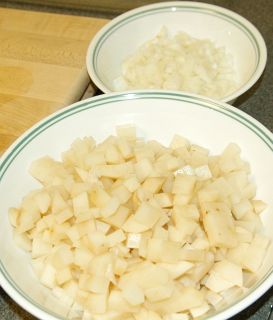
Drain the clams from two 10-ounce cans of clams (preferably canned in water, salt water, or broth - not oil). After draining, both cans should yield about a total of 10 ounces of clam meat. Also, prepare 8 ounces of clam juice. The flavor is better if you use bottled clam juice instead of the liquid the clams are packaged in, but if clam juice is unavailable, reserve 8 ounces of the liquid from the cans.
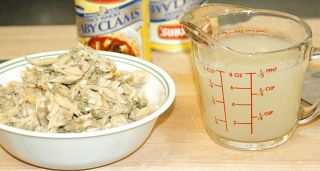
Heat two tablespoons of bacon grease and saute the onions in the hot grease until translucent, but not browned. Bacon grease can be collected and stored after you cook bacon. If you don't have any bacon grease in your refrigerator, go ahead and cook about four slices of bacon in the pan and remove the bacon and any excess bacon grease (remember to store it for future use) before sauteing the onions.
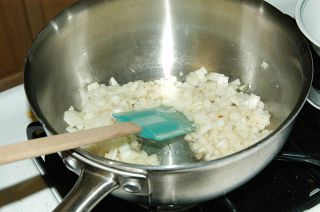
Add the diced potatoes and saute until all the potato has been coated by the fat. Throw in the tablespoon of flour and saute until the potatoes and onions have been coated.
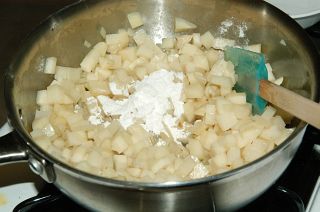
Pour in the cup of clam juice and bring to a boil while stirring. Once the mixture comes to a boil, reduce the heat so it just simmers with the lid on. Cook with the lid on for 20 minutes or until the potatoes are tender.
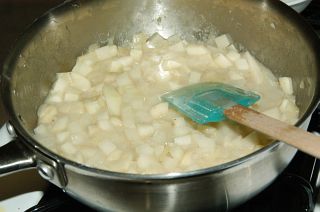
Prepare a mixture of one cup whole milk and one cup heavy cream. Half-and-half will also work as long as it's on the creamier side - if not, augmentation with some heavy cream may be necessary. The amount of fat is important for the texture of the chowder. Using only milk will result in a slightly thickened (due to the potato starch) watery consistency. Using only heavy cream will result in a really smooth, but much too rich chowder. The milk and cream mixture results in a cream fat concentration around 20%, producing what I think is the perfect consistency when served hot or warm. Using combinations of milk and cream to achieve this fat ratio helps us get to our desired consistency target. For example, some light whipping cream (about 18-30% fat content) has a fat content as low as 18%, so using straight light whipping cream of this type will provide us the desired amount of fat.
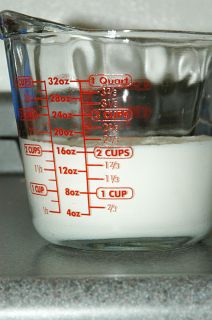
Once the potato, onion, and clam juice mixture has simmered for 20 minutes, stir to redistribute the solids.
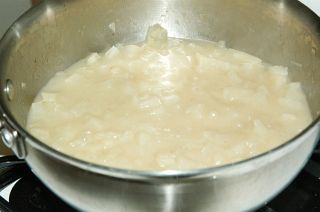
Add the drained clams, milk, and cream.

Stir and heat through until hot, but not boiling. (Boiling may cause some of the milks solids to clump - but with 20% fat concentration this is less of a problem than if we were using straight milk. At around 30% or more fat, there is enough fat to prevent the clumping of the milk solids even while boiling.) While heating, this is right time to season with salt and pepper. Add salt a pinch at a time, stir, and taste. Repeat until you get the desired saltiness. It is important not to forget to add the salt and pepper - even though we have a lot of flavors in the chowder at this point, they will be muted without adding enough salt.
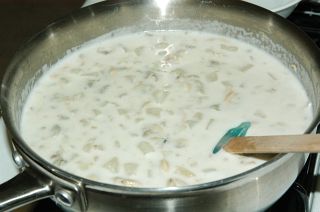
Serve while hot. I like garnishing with a bit of fresh chopped parsley and some bacon pieces.
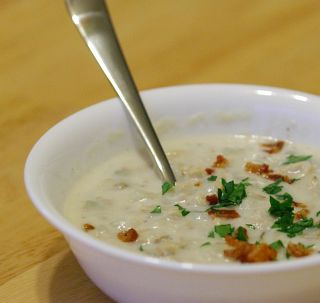
I started off by assembling the main ingredients: 6 oz. (170 g) asparagus tips, 2 Tbs. chopped parsley, 12 oz. (340 g) orzo, 1 cup (235 mL) chicken broth, 3 oz. (55 g) butter, and 1/2 cup (50 g) grated parmesan cheese.
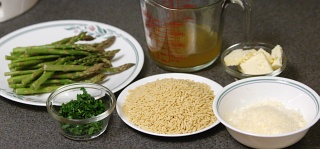
I also shelled, deveined, washed, and drained 1/2 pound (225 g) medium shrimp (about 30-40 count).
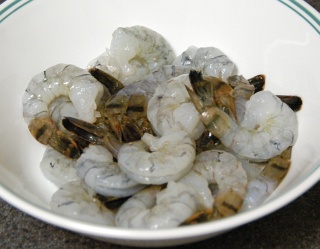
I brought about 2 quarts of water to a boil in a medium saucepan. (Next time I make this recipe, I'll probably use a larger pot - you'll see why when I cook the orzo.) When the water began to boil, I threw in about a tablespoon of salt and stirred until the salt dissolved. I dropped in the asparagus tips and allowed them to cook until tender - about four minutes.
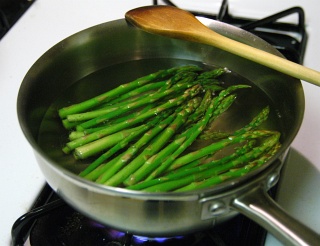
I removed the asparagus from the water and set them aside on a plate. Then, I took the orzo and poured it into the water that I had used to cook the asparagus. I cooked the orzo until al dente - nine minutes.
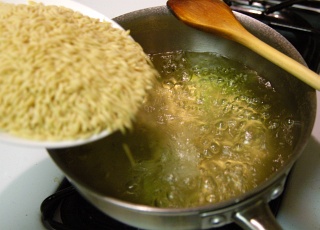
Meanwhile, I melted the six tablespoons of butter in a large saute pan.
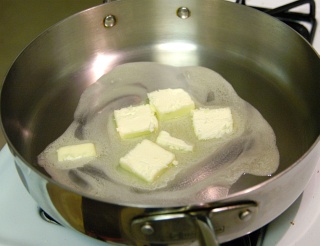
Once the butter was melted, I let it brown until it produced a nutty fragrance. I drained the shrimp one last time and added them to the pan. I lightly salted and peppered them. Then, I cooked the shrimp for one full minute before flipping them over and cooking for a final minute.
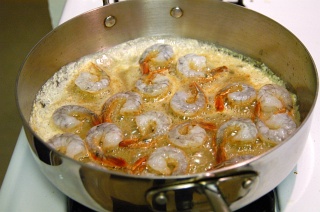
While the shrimp was cooking and the orzo was boiling, I cut the asparagus until 1-in. (2.5 cm) pieces.
The shrimp was then removed to the same plate as the asparagus. By now, I realized that I had just enough water in the orzo pan to cook the orzo, but wouldn't have much left over. I was a little concerned that if I couldn't drain the orzo, then it might be too salty. The recipe calls for reserving 1/4 cup of the pasta water, and it looked like that was just about all I was going to have left over in the pan. So I decided to skip reserving the water.
I poured the chicken broth into the sauté pan to deglaze it. In the original recipe, 1/4 cup of reserved water from the drained orzo would also be added to the pan. Since I didn't have much water left in the orzo pan, I didn't drain it at all. I thought about rinsing the orzo to reduce the salt content (however, this will adversely affect the texture of the final dish as the starch content in the water is reduced) but felt that the saltiness wasn't overwhelming. I decided to take a chance and proceeded with the recipe. I used a wooden spoon to scrape up any brown bits on the sauté pan, then, when the broth started to bubble, I poured it into the orzo pot.

I stirred the orzo and broth over medium heat until the liquid thickened a bit and became creamy.
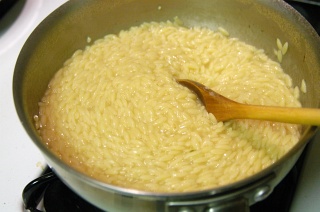
Then I put the cut asparagus and shrimp back in the orzo and mixed until heated through.
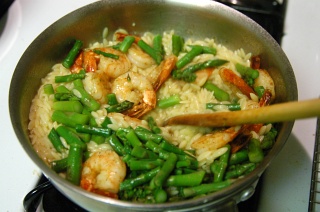
I removed the pot from the heat and mixed in the chopped parsley and grated parmesan. Taste the orzo at this point to determine if additional salt and pepper should be mixed in. Lucky for me, the saltiness was just right. I did add some freshly ground pepper.

The orzo risotto reminded me of Rice-A-Roni, except fresh and wonderful tasting. The clean seafood taste and creamy texture was great. This is definitely a dish I'd make again.
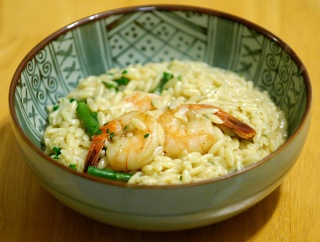
Wednesday, March 08, 2006
Sunday, November 06, 2005
Misc: Nov 3, 2005

jane_hamley_wells_kitty_hou.jpg
Sometimes it's the design that makes reference to the function it serves that creates attention. Jane Hamley Wells creates a whimsical, painted pine solution to the kitty house. JGB"
Thursday, November 03, 2005

Absinthe,
perhaps the most mythologized of alcoholic beverages, has inspired
artists and writers, ruined many, and left many more with headaches and
the inquiry, “Was that it?” When absinthe redeveloped a cult following
in the ‘90s, most people realized that it was illegal to buy in the US.
So they waited until their friends came back from Portugal with a
bottle and left it at that. What most people don’t realize is that it’s
actually legal to possess absinthe in the US—you just have to buy it
internationally, which can be done online at Absinthe.bz.
It’s going to set you back a little bit, but being able to pull out a
bottle of the green fairy at a party may just be worth it.
Update:
productdose reader Simon from Switzerland (where Absinthe was
originally developed), who “pretty much grew up with the stuff,”
responded with his own thoughts: “Don’t buy Czech or Spanish absinth.
These absinthes are garbage—no effect whatsoever and taste horribly.
There are a few real Absinthes out there (Kuebler is one). Then there are a few home-made La Bleue out there ([expensive] though), but with very high Thujone content. I think the best, currently, in terms of flavor and effect, is from [Jade Liqueurs]. [Thanks, Simon!]
| Via gonadfan |
Thursday, October 27, 2005
CatBib Stops Cats from Catching Birds
 alt="CatBib" border="0">The CatBib hangs from your cat's collar and prevents it from catching birds.
alt="CatBib" border="0">The CatBib hangs from your cat's collar and prevents it from catching birds.It
works by interfering with its ability to hunt, disrupting its sense of
timing, and coordination, and thereby removing its stealth ability. But
it doesn't interfere with its other activities. It can still climb
trees, scratch up some kitty litter, scratch up your couch, all the
other cat goodness.
Considering the Bird Flu going around the world, might be a good thing.
The
CatBib is made of thin light-weight neoprene (less than an ounce),
stretchy, durable, and easy to care for. Machine washable, and comes in
5 colors: Blue, Red, Teal, Burgundy, and Purrple.
$7.95 from CatGoods
Via Militant Platypus
Wednesday, October 26, 2005


